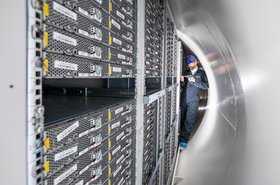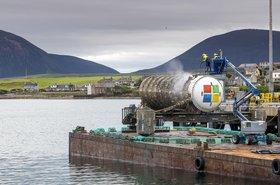As rack densities grow and data center cooling costs rise with them, several companies have trialed submerging data centers in the sea.
Microsoft has been the most notable company to test the concept, with its high-profile Project Natick - although the company has not spoken about the initiative in years.
Now, a YouTuber has shown that anyone could have their own underwater facility, at least in miniature, by building a submersible PC.
The project, built by YouTuber DIY Perks and viewable below, follows the same core idea - that large bodies of water are able to cool IT equipment passively - but at a smaller scale, with the PC dunked in a pond.
DIY Perks, real name Matthew Perks, built a system featuring an Nvidia GeForce RTX 4090, Intel Core i9 13900K, three 4TB Crucial T700 SSDs, and a 1000W power supply, for around $5,000. The 800W computer was encased in an acrylic glass and copper frame and has a fully closed-loop water-cooled system. A USB-C cable back to land provided power and connectivity, allowing Perks to test the system from a monitor set up on terra firma.
"That the PC is able to dump its heat so quickly into the surrounding water really is a good indicator of how capable the cooling system is, and I'd say we're only scratching the surface of what it's capable of cooling," Perks said.
The larger-scale Natick project began in 2013 when Microsoft researcher Sean James, previously a US Navy submariner, wrote a paper proposing underwater data centers. In 2014, the company decided to do it for real, and put together the Natick team under Ben Cutler.
The next year, Microsoft submerged an eight-foot (2.4m) cylinder, 30ft (9m) underwater off the Pacific coast of the US in 2015, following it up three years later with 12 racks of servers in a container 12m long, which it ran for two years in 117 feet of water in Scotland’s Orkney Islands.
That effort was claimed to be a success at the time, and Microsoft patented the idea for a giant “reef” of containers holding servers, nothing has since come out of Project Natick. On LinkedIn, Cutler still lists his job as leading Natick "to determine the feasibility of subsea data centers."
While the company moves slowly, rivals in China have stepped in to fill the void.
A company called Beijing Highlander launched a four-rack test vessel at the port of Guangdong in early 2021, and ran live China Telecom data on the servers later that year.
That same year, Highlander followed up with a bigger test at the Hainan Free Trade Port, and announced the world’s first commercial underwater data center would be constructed from 100 of its data cabins, networked on the sea bed, connected to land by power-and-data cables, and powered by low-carbon electricity from Hainan’s nuclear power station.
Coastal regions of China are adopting the idea of underwater data centers. The concept is included in the five-year economic plans of several Chinese regional authorities, including the provinces of Hainan and Shandong, as well as the coastal cities of Xiamen and Shenzhen. In Hainan, contracts were signed to deliver the data center in January 2022.
Back in the US, startup Subsea Cloud plans to offer data centers submerged in the deep ocean. While Highlander and Microsoft's Project Natick both use pressure vessels, Subsea's designs equalize the pressure, bringing the inside of the unit to the same pressure as water at that depth. This means that the company can use simpler, lighter pods than the heavy-duty pressure vessels otherwise needed - if it is able to pull off its ambitious plans.
The company announced three underwater data center projects last year.




